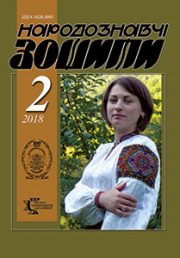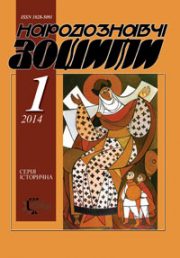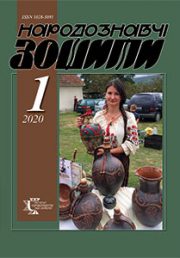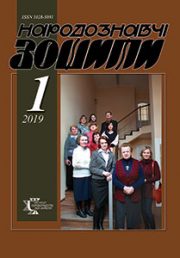The Ethnology Notebooks. 2022. № 6 (168), 1448—
UDK [398.332.416:792.246](=161.2)”192/193/20″
DOI https://doi.org/10.15407/nz2022.06.1448
PAPISH Maria
- ORCID ID: https://orcid.org/0000-0003-2701-7841
- Master of Philology,
- Head of the Folklore Laboratory,
- Ivan Franko Lviv National University,
- 1, University St., 79000, Lviv, Ukraine,
- Contacts: e-mail: papishmarichka1@gmail.com
Abstract. The folk Christmas drama Nativity scene enriches and diversifies the folkloric tradition of the Ukrainians and it is one of the brightest spectacles at Christmas time in the modern world. That is why even today the scientists are interested in this folklore phenomenon. The relevance of the study of the Ukrainian folk nativity tradition is due, first of all, to its active presence in our time and the need to interpret the phenomenon of folk Christmas drama as a socially active and open phenomenon. In particular, the plot about the worship of the three kings in the folk context of the Christmas drama acquires a different connotation, a different semantic meaning.
The purpose of the scientific research is to reveal the functional features of the image of the three kings and their variations in the character composition of the national Christmas drama: from the biblical sages to the leaders of the Ukrainian people.
The object of investigation is the folk Christmas drama, and the subject is the modification of the religious plot about the three kings in the folk Christmas drama.
The subject and purpose of the research has led to the usage of the following research methods: structural — as the main one for a comprehensive analysis of the constituent elements of the story line about the three kings; comparative, which makes it possible to draw parallels to the established image of the three kings at different stages of the existence of the folk Christmas drama; historical and cultural — with the aim of establishing the specifics of the nativity scene and clarifying the socio-cultural dimensions of the influence on the folk Christmas drama.
The article examines the figurative system of the plot about the three kings on the basis of the records of the 20s and 30s of the 20th century and modern fixations of folk Christmas dramas. The substantive basis of the plot and the ideological and substantive transformation of the images against the background of historical and social events of the 20th—21 st has been found out. A number of plot types, outlined through the prism of ideological and content load and functionality of traditional and actualized images of the three kings has been singled out, namely: 1) the three kings — the biblical sage kings; the Russ (ancient Ukrainian) princes; the leaders of the Ukrainian people of the different historical periods; the representatives of the different regions of Ukraine; the current Ukrainian politicians.
Keywords: the Ukrainian folk Christmas drama, the «vertep», the character system, three kings, actualization.
Received 15.11.2022
REFERENCES
- Franko, I. (1982). To the history of Ukrainian vertep (Vol. 36, pp. 170—375). Kyiv: Naukova dumka [in Ukrainian].
- Kyrchiv, R. (2010). Twentieth Century in Ukrainian folklore. Lviv [in Ukrainian].
- (2007). Bible. The Holy Scriptures of the Old and New Testaments. Kyiv [in Ukrainian].
- Kehrer, Hugo. (1908). The three kings in literature and art (Vol. 1, p. 22). Leipzig [in German].
- Herus, L. (2017). Nativity crib (shopka) in Ukrainian Christian tradition genesis, history, symbolic. The Ethnology Notebooks, 3, 579—595 [in Ukrainian].
- (2006). Ostroh Bible. Lviv [in Ukrainian].
- Shevchenko, V. (2004). Reference on theology. Kyiv: Naukova dumka [in Ukrainian].
- (1991). Holy Scripture of the Old and New Testament. United Bible Societies [in Ukrainian].
- Vertep. Sokal, January 8, 2016. Retrieved from: https://www.youtube.com/watch?v=CMR22LWFj2w
- Vertep in the village of Losyatyn, Kremenets district, Ternopil region. January 7, 2018. Retrieved from: https://www.youtube.com/watch?v=HDd4cMhCA40.
- Vertep in the village of Dibrova. January 10, 2013. Retrieved from: https://www.youtube.com/watch?v=IyAmIx159pc.
- (2017). FA KUF. Folklore archive of the Department of Ukrainian Folklore named after Academician Filaret Kolessa of the Ivan Franko National University of Lviv. Fond OEK. Ser. OEK_MP20170107. Spr. OEK_MP20170107papish. Od. zb. OEK_ MP20170107 papish_seans01_video01.
- Volyts’ka I. (1992). Theatrical elements in traditional rituals Ukrainian Carpathians late XIX — early XX century. Kyiv: Naukova dumka [in Ukrainian].
- (1996). Volyn vertep: repertoire set for folklore theatres [in Ukrainian].
- (1930, January 6). Vertep. Recorded in the village of Golovetsko, Skoliv district, by teacher Yaroslav Kedr. Nedilya. Ilyustrovanyy tyzhnevyk, 1 (70), 14—15 [in Ukrainian].
- Habrusevych, I. (1924). Ukrainian vertep for schoolchildren and scouts. Lviv [in Ukrainian].
- Shkrumelyak, Yu. (1936). Guests from Bethlehem: Vertep for the house and stage. Lviv [in Ukrainian].
- Remezivs’kyy, F. (1939). А new Ukrainian vertep for the house and the stage. Zolotyy Kolos. Kalendar na perestupnyy rik 1940 (Pp. 48—49). Lviv [in Ukrainian].
- (1930, January 6). Vertep of the People’s House of the city of Chodorov. Sent by Marta Medvedytska. Nedilya. Ilyustrovanyy tyzhnevyk, 1 (70), 10—12 [in Ukrainian].
- (2000). We carry the joyful news: Vertep and congratulations. Lviv: Svichado [in Ukrainian].
- Zavitiy, B. (1998). Ukrainian folk drama about King Herod (an attempt at systematization). The Ethnology Notebooks, 6, 646—654 [in Ukrainian].
- Halahan, H. (1882, october). Maloruski vertep. Kyevskaya staryna (Pp. 1—38). Kyiv [in Ukrainian].
- Smolyak, P. (2009). Ancient and present-day forms of singing carol traditions in the Western Podillya. Scientific notes of Ternopil National Pedagogical University named after Volodymyr Hnatyuk. Series: History, 1, 154—160 [in Ukrainian].
- Kharchyshyn, O. (2005). Vertep drama in contemporary youth and student environment. Folk art and ethnography, 6, 65—71 [in Ukrainian].
- Yakubovs’kyy, V. (2012). Modern recordings of vertep performances (based on folklore materials from Galychyna). Actual problems of Slavic philology. Series: Linguistics and Literary Studies: Interuniversity Collection of Scientific Articles Berdyans’k (Issue XXVI, part I, pp. 313—321) [in Ukrainian].
- Christmas vertep from Lviv scouts. The 2014 year. Retrieved from: https://www.youtube.com/watch?v=ph0Rlz-wqHM [in Ukrainian].
- Political Christmas vertep in Ternopil. January 8, 2013. Retrieved from: https://www.youtube.com/watch?v=P7NvLFcSJ9k [in Ukrainian].
- Vovchak, A. (2013). Folk puppet Christmas drama (betleyka) in outskirt of Khyriv in Staryy Sambir district of Lviv region. The Kolessas: the Succession of Scholarly and Artistic Traditions (Dedicated to the 140-th Birth Anniversary of the Academician Philaret Kolessa): Сollection of scholarly papers and materials (Pp. 306—309). Lviv: Ivan Franko National University [in Ukrainian].







